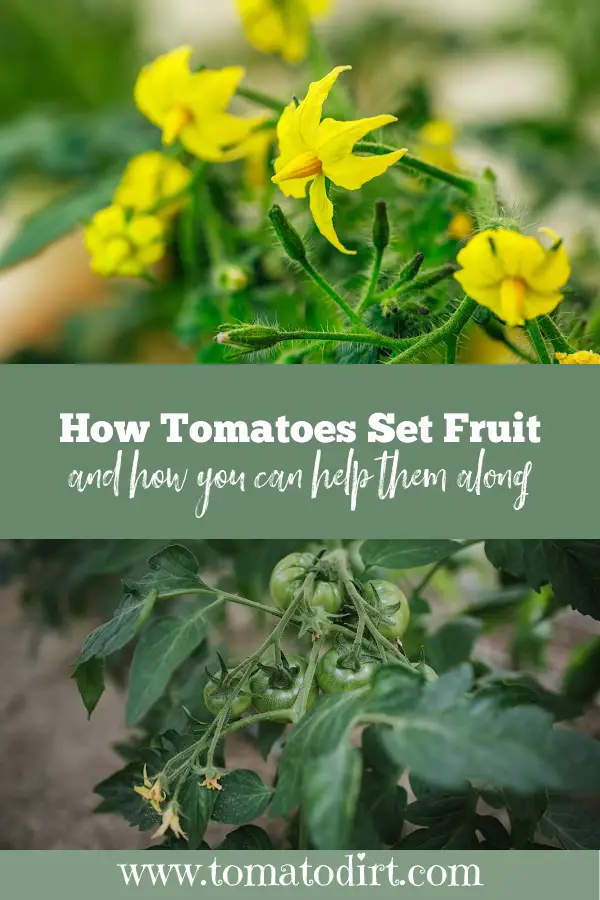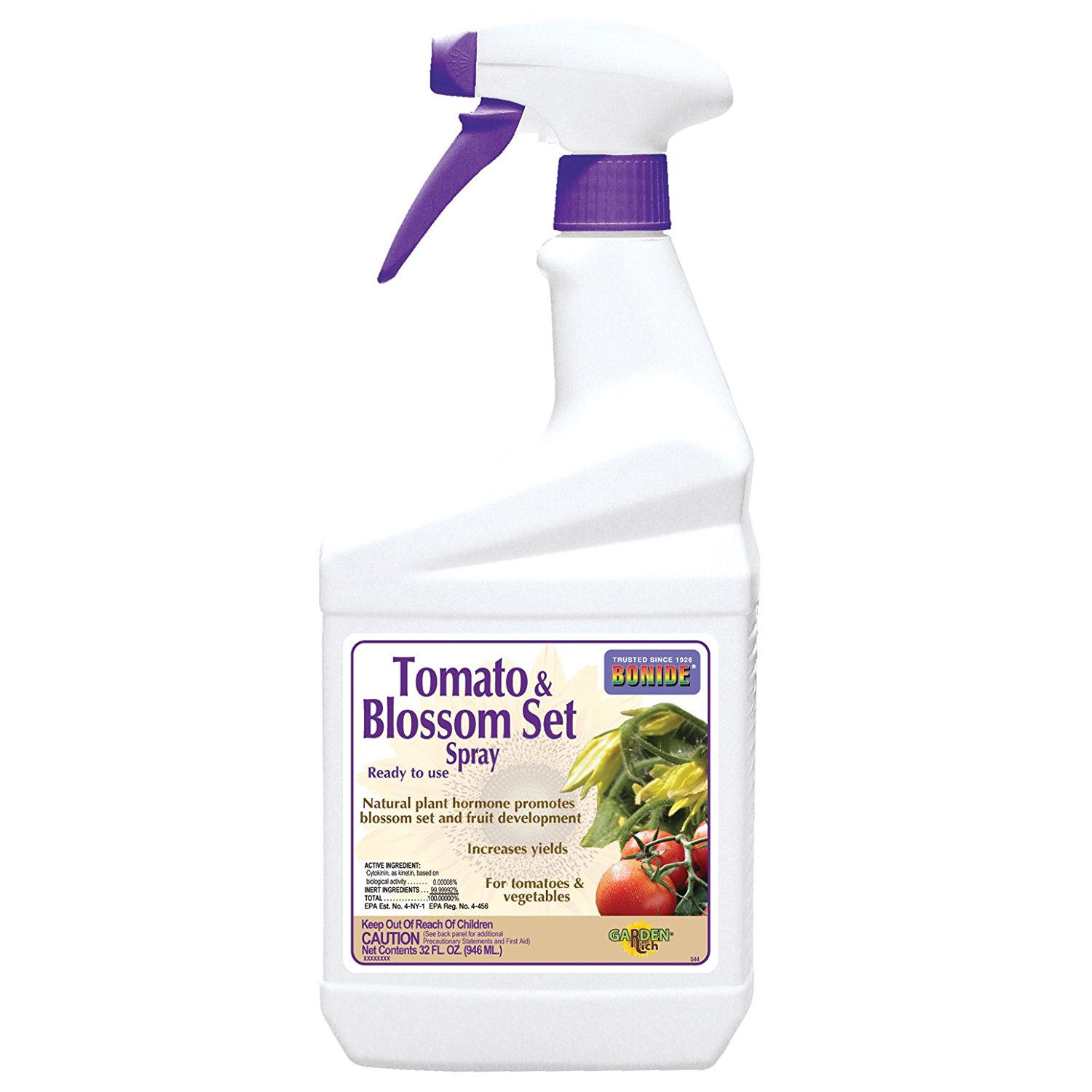FREE: 10 Must-Know Tomato Growing Tips Get The Guide
Read our affiliate disclosure here.
Help Your Tomatoes Set Fruit with These Tips
Since 2010, Tomato Dirt has garnered 4.8+ million views, making it the web’s leading online source for growing tomatoes in the home garden. Award-winning writer and Tomato Dirt owner Kathy Widenhouse has helped thousands of home gardeners grow healthier tomatoes. Be one of them when you get Tomato Dirt’s Growing Guide here.
Does your tomato plant need help to set fruit?
Here's the scenario: your tomato plants have a plethora of flowers. But after a couple of weeks, you see the blossoms on the ground and no baby tomatoes in their places.
Answer: your tomatoes have not set fruit.
And yes, you can help. If you know what causes tomatoes to drop their blossoms – and how you can help them face stressful conditions that prevent fruit set – you can help your plants produce the best crop possible. Use these tips.
Help your tomatoes set fruit
How does a tomato set fruit?
Tomatoes are self-pollinating. A tomato blossom has both male and female parts. The flower’s stamen (male part) releases pollen in the center of the flower – the pistil (female part.) Tomato pollen is heavy and sticky, so if wind and insects are active then the flower is fertilized easily and within the necessary window – the first 50 hours after blossoming. When that happens, the beautiful little bud goes on to form a tiny fruit that grows into a tomato. The process is known as “setting fruit.”
How long after flowering does a tomato set fruit?
From blossom to itty bitty tomato can take 20 to 60 days, depending on the tomato variety. Smaller tomato varieties and short season varieties set fruit much more quickly than larger tomato varieties and long season varieties.
Why do tomato plants bloom but not set fruit?
Sometimes a healthy tomato plant flowers, its blossoms drop, and no fruit develops. This is called “blossom drop.” Plenty of things can happen that can throw the pollination process off course and prevent tomato fruit set. They all boil down to one word: stress. Like you, tomato plants experience stress. Their stress factors include …
- Extreme temperatures. Cool nights (consistently below 55ºF) or hot spells (days consistently about 90ºF and nights consistently above 75ºF) force the tomato plant to abandon fruit production and focus merely on surviving. Plus, cool overnight temperatures interfere with pollen production.
- Humidity. The ideal humidity range for tomato pollen is 40-70%. Too high or too low and the plant has difficulty with pollination. When humidity is low, tomatoes have trouble producing pollen. The pollen has trouble sticking to the stamen. When humidity is too high, then pollen is overly-thick and the blossom struggles to release it.
- Poor pollination. When temperatures are too hot or too cold, insects aren’t active in the garden. Not as many blossoms are pollinated.
- Water stress. Tomatoes have deep root systems. Shallow watering develops shallow root systems, which can weaken tomato plants.
- Unbalanced nutrition. Tomatoes are heavy feeders. Nitrogen (represented proportionally by the first number in a fertilizer’s three-number NPK series) encourages leaf growth. Too much nitrogen-rich fertilizer, without accompanying phosphorus and potassium – or a poorly balanced mixture of nutrients in the soil – can mean plants develop more leaves than fruit.
- Too many blossoms. When a healthy tomato plant has many blossoms, they compete for food. Some won’t survive.
How do I get my tomatoes to set fruit? 9 tips
Given that you’re not Mother Nature, you can’t control the weather – that is, the temperature and the humidity. However, you can take a few steps to help along the process from bud to fruit.
Reduce extreme temperature stress
1. Don’t plant tomatoes too early in the season. Doing so eliminates large fluctuations in temperatures associated with the first days of spring.
2. Also, choose types of tomatoes that are most appropriate for your climate. In cooler areas, plant early varieties which are more tolerant of cold nights. In southern regions, plant heat-tolerant varieties, which are more accustomed to setting fruit when the thermometer stretches upward. And if your local area experiences a heat wave during tomatoes’ flowering stage, use shade cloth to protect tomato plants during hottest time of day.
3. As for nighttime chill, you can reduce stress in tomato plants by covering them with blankets or other kind of frost protection. Tomatoes won’t set fruit until overnight temperatures are 55 degrees F for at least two nights in a row. Low temperatures inhibit pollen release. If you can take the edge off the cold, you can help along the fertilization process.
Reduce the stress of low humidity
4. In dry areas – or when humidity is low, as in less than 40% for more than a couple of days – help pollen stick by misting tomato plants.
Reduce pollination stress
5. Plant tomato plants with at least 24-36 inches between them. This will allow for plenty of air circulation and encourage breezes and bugs, which are the two most productive pollination factors in the garden. While you’re at it, plant flowers that attract insects among your tomato plants.
6. You can help physically pollinate flowers yourself. When blossoms emerge, mimic the work of wind and insects by gently shaking plants to spread pollen.
Reduce water stress
7. Make sure tomato plants get 1-3 inches of water a week (including rain). Avoid watering daily, but rather water deeply a couple of times a week to allow root systems to grow strong. Water plants at the soil line – not on stems, leaves, or fruit.
Reduce nutrient stress
8. Test your soil before planting tomatoes and supplement the garden with deficient nutrients. Then work a layer of compost into your vegetable garden before planting tomatoes.
9. At planting time, apply a balanced NPK fertilizer (10-10-10). But when the first flowers emerge? Switch to a phosphorus and potassium-focused fertilizer (5-10-10) or better yet, one especially formulated for tomatoes, such as Tomato Tone or Miracle Gro Tomatoes. Tomato flowers and fruit need phosphorus and potassium during the flowering and fruiting stages.
Will tomatoes set fruit in hot weather?
Tomatoes’ optimum daytime temperature range for setting fruit is between 70º-85ºF. But pollen becomes sterile in sustained temperatures over 86ºF. Yet when that happens to your plants, all is not lost. After temperatures head down to a more reasonable level, plants will produce new flowers once again.
Can tomato set spray help my plants to set fruit?
Some gardeners use tomato fruit set spray (also called blossom set spray or tomato hormone spray) early in the growing season, when temperatures are cool. The spray does not pollinate flowers – the key step to setting fruit. Instead, hormones in the spray enlarge the flower’s ovule, which to your eye means it “sets fruit.”. Plants treated with fruit set spray may produce tomatoes that vary in size, be misshapen, or have some distortions as compared with tomatoes that set fruit normally.
Know what you can – and can’t do – to help tomatoes set fruit
The biggest reasons tomatoes don’t set fruit? Temperature and humidity. You can’t control those.
But you can help your tomatoes survive through those stressful spells. And maybe with a bit of TLC they will produce some wonderful fruit now … with a guarantee of more later when conditions even out.
More tomato problems and how to solve them
Blossom Drop: why fruit doesn’t set and what to do about it …
15 ways to prevent blossom end rot in tomatoes ...
Sunscald: why too much sun can be hazardous to tomatoes...
Why
a tomato cracks and what to do about it ...
Are bumps on tomato stems harmful to plants?
Blossom end rot: how to identify, treat, and prevent it ...
Tomato Catfacing: How to Identify and Prevent It ...
How to identify tomato problems and prevent them ...
More tips for managing tomato problems on our Pinterest board ...
Return from Help Tomatoes Set Fruit to Tomato Dirt home
As an Amazon Associate and Rakuten Advertising affiliate I earn from qualifying purchases.
SHARE THIS PAGE:
FREE! 10 Must-Know Tomato Growing Tips: 20-page guide
Get yours here:





